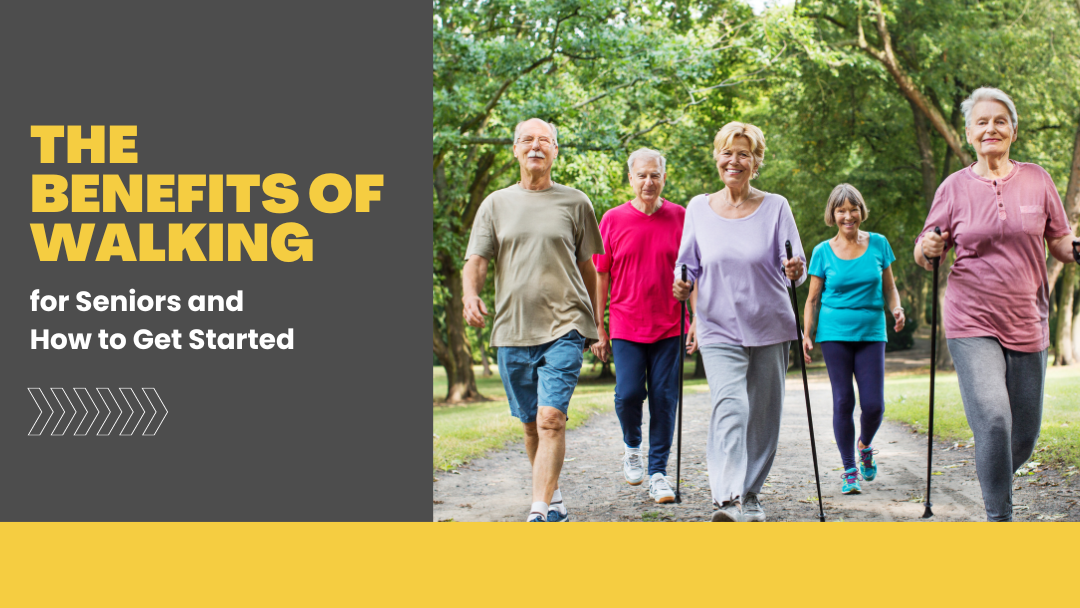
Walking is a simple yet powerful form of exercise that offers numerous benefits for people of all ages.
For seniors, in particular, walking provides an accessible and low-impact way to stay active, improve overall health, and enhance quality of life. In this article, we will explore the benefits of walking specifically for seniors and provide some practical tips to help you get started on a walking routine that suits your needs and abilities.
The Benefits of Walking for Seniors:
- Improved Cardiovascular Health: Regular walking can help strengthen your heart and improve cardiovascular health. It promotes better blood circulation, lowers blood pressure, reduces the risk of heart disease, and improves overall cardiovascular endurance. Even moderate-intensity walking can have a significant impact on maintaining a healthy heart.
- Increased Strength and Mobility: Walking engages multiple muscle groups, particularly in the legs and core. By incorporating hills or inclines into your walking route, you can further strengthen your leg muscles and increase overall lower body strength. Improved strength and mobility can enhance balance and stability, reducing the risk of falls and maintaining independence in daily activities.
- Weight Management: Walking is a natural and effective way to manage weight. By engaging in regular walking sessions, you can burn calories, maintain a healthy body weight, and reduce the risk of obesity and related health conditions. Combined with a balanced diet, walking can contribute to long-term weight management and overall well-being.
- Enhanced Mental Health: Walking has positive effects on mental health and well-being. It stimulates the release of endorphins, which are natural mood boosters and stress relievers. Walking outdoors provides an opportunity for fresh air, exposure to nature, and a change of scenery, all of which can improve mental clarity, reduce anxiety, and promote a positive mindset.
- Social Engagement: Walking can be a social activity, offering opportunities for connection and companionship. Consider joining a local walking group or inviting friends, family, or neighbors to join you on your walks. Social interaction while walking not only adds enjoyment but also provides emotional support and accountability, making it easier to stay consistent with your routine.
Getting Started with Walking:
- Consult with your Healthcare Provider: Before starting any new exercise routine, it’s essential to consult with your healthcare provider, especially if you have any pre-existing health conditions or concerns. They can provide personalized advice and guidelines based on your specific needs and help you determine a safe and suitable walking plan.
- Start Slowly and Gradually Increase: If you’re new to walking or haven’t been active for a while, it’s important to start slowly and gradually increase your walking duration and intensity. Begin with shorter walks at a comfortable pace and gradually extend the distance and duration as you build endurance and confidence.
- Choose Proper Footwear and Attire: Invest in a pair of comfortable, supportive walking shoes that provide cushioning and stability. Opt for breathable, moisture-wicking clothing that allows for freedom of movement. Dress appropriately for the weather conditions and consider wearing sunscreen and a hat for sun protection.
- Set Realistic Goals: Set realistic and achievable goals for your walking routine. Start with a target of a certain number of steps per day or a specific duration of walking. As you progress, you can gradually increase your goals. Remember, every step counts, and consistency is key.
- Mix Up Your Walking Routes: To keep your walks interesting and enjoyable, explore different routes and environments. Walk in your neighborhood, local parks, or nearby trails. Consider incorporating scenic routes or landmarks to add variety and motivation to your walks.
- Warm-up and Cool-down: Before each walking session, spend a few minutes warming up your muscles with gentle stretches or movements. After your walk, take a few minutes to cool down.
Walking is a wonderful exercise option for seniors, offering a wide range of physical and mental health benefits.
By incorporating regular walking into your routine and following the tips mentioned above, you can experience improved cardiovascular health, increased strength and mobility, weight management, enhanced mental well-being, and social engagement.
Embrace the power of walking and take the first step towards a healthier, more active lifestyle today.


